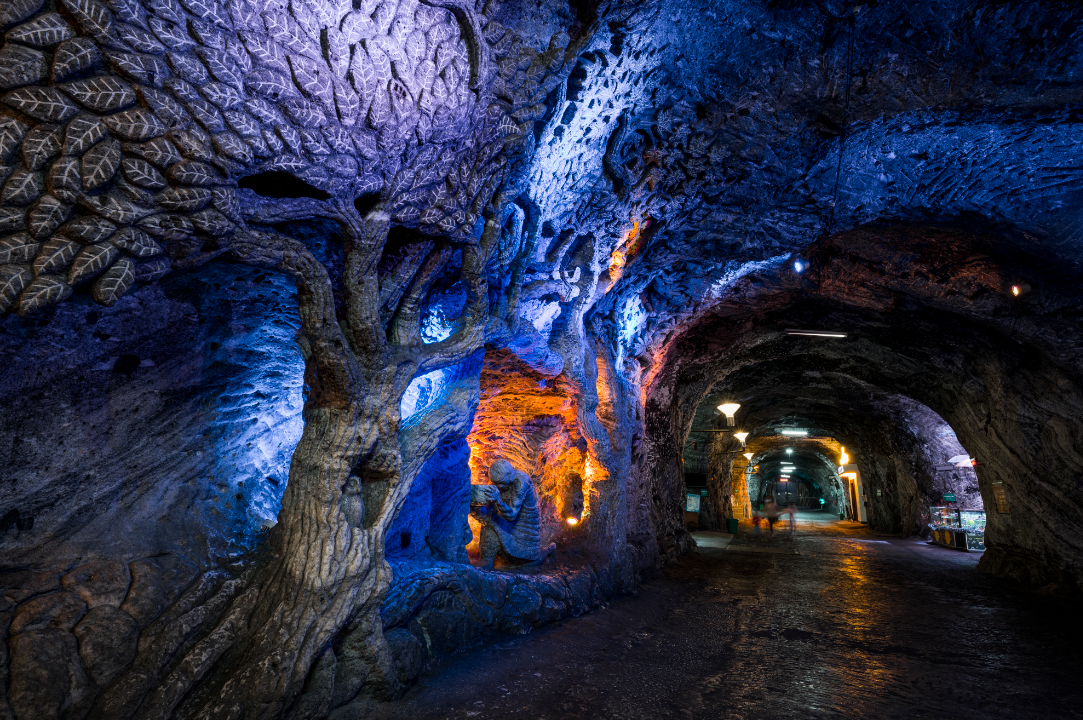COLOMBIA
The Zipaquira Salt Cathedral: a temple and a masterpiece
COLOMBIA

First there was the light of day, then darkness. Little by little, a multicolored phosphorescent light appeared and illuminated the walls of the Zipaquirá Salt Cathedral, a monumental architectural masterpiece built by the miners' own hands and which became a beautiful temple.
Before entering the Zipaquira Salt cathedral, the first thing you see is the plaza of flags where you will find the sculpture of the Virgen de Guasá (meaning salt and water). She is the miners' patron saint and has a miner at her feet. In the Ceremonial Plaza you will see the Cardinal Cross, the mining monument, the bell tower and the fountains. The mine's lighting dazzles tourists.
This wonderful salt mine is in the town of Zipaquirá, capital of the department of Cundinamarca, only 48 kilometers from Bogotá. It is buried deep in the hill of Zipa (the name of the most important indigenous chief), at 2,652 meters above sea level with an average temperature of 14˚C.
First wonder of Colombia
This underground attraction has received more than 13 million visitors from all around the world. Ten thousand foreign tourists and 40 thousand Colombian tourists go there every month. Its structure, a mix of precise engineering and interesting history, led it to be declared the First Wonder of Colombia on February 4, 2007.
In 1995, the new site of the Zipaquira Salt Cathedral was inaugurated, as the first mine was unstable. This new construction is 180 meters underground. To build it, 250 thousand tons of rock salt had to be extracted. This mine is the largest deposit of rock salt in the world.
When entering the Cathedral you can smell the minerals and the darkness takes hold of everything. Shortly after, a set of lights uncovers the carved rock and the tunnels that house the Stations of the Cross. At the end are three naves representing Jesus' birth and baptism, his life and death and, finally, his resurrection. Each one has an altar.
Every nave has beautiful sculptures carved by miners and sculptors. Among them is La Piedad which sharply stands out. Her face has strong indigenous features, in honor of the Muiscas who were the first to take advantage of and use salt. There is also the Guardian Angel carved in 1950 by Italian sculptor Ludovico Consorte and an enormous cross in the entry hall.
Another one of the main attractions is the mirrors of water, previously full of brine water (where the salt was saturated). The surroundings are illuminated by the reflection of the light on the water creating a fascinating optical effect of swimming in an underground cavern. The mine has bilingual guides for foreign tourists.
You might be interested: Cundinamarca and myth, not far from Bogotá
History of the Zipaquira salt mines
The use of this mine has a history going back to pre-Columbian times and continuing in colonial and republican eras to the present day. The ancient Muisca indigenous people were the first to benefit from this enormous salt deposit, which turned them into one of the most prosperous pre-Hispanic societies of their time.
This salt deposit in the middle of the eastern Andean mountain range was formed 70 million years ago when an inland sea covered the region. As the Eastern Mountains were forming, the sea dried out and left an enormous deposit of salt buried below the earth and mud. It solidified until it became rocks of salt.
The Spanish declared the site the "City of Whites" by vice regal decree. Later, the salt was used to finance the campaigns of the liberators Nariño and Bolívar who brought independence to Colombia, Ecuador, Peru and Venezuela 200 years ago. Decades later, writer and Nobel Prize winner Gabriel García Márquez started his life as a writer when he lived in Zipaquirá.
The city preserves many of the buildings from colonial times and the main plaza (the great plaza or plaza of the people) is protected by the Town Hall. The architecture is notable for its balconies, decorative colonial windows and thick walls. The exclusive El Libertador Inn was built in 1948 in a neo-colonial style with Moorish influences.
Attractions and features inside the mine
● The tour inside the Zipaquirá Salt Cathedral lasts 60 minutes. Weddings are also held in the cathedral.
● The miner's route is a guided tour during which tourists can experience life as a miner, with staff and security teams. It lasts 30 minutes.
● The Brine Museum, in the old structures where salt was processed. Tour lasts 20 minutes.
● 3-D video taking a trip through the different geological stages to show tourists how salt developed. 15 minutes. “Guasa, treasure of a people”.
● Food hall with capacity for 300 people.
● Auditorium and convention center with capacity for between 260 to 800 people. Perfect for seminars, launches, events, corporate meetings, etc.
● The Coffee Chamber has ambient music and serves delicious Colombian coffee.
● Rock climbing wall: the highest in Colombia.
Opening hours and rates
Opening hours: Monday to Friday from 9:00 am to 4:30 pm, Saturdays and Sundays from 9:00 am to 5:00 pm. Sunday Mass at 1:00 pm.
Website: www.catedraldesal.gov.co/
It is forbidden to take in pets or food, or to smoke or consume alcohol inside.
Nemocon, another great salt mine
The salt mine in Nemocon houses a 1,600 kg salt crystal carved by a miner. Near to Zipaquirá, is Nemocon, a town which also has an impressive salt mine with over 500 years of history. The mine is 800 meters deep. It has a large chamber with mirrors of salt water, an events room, a wishing pool and a waterfall of salt which is more than 80 years old.
In the chapel chamber, there is an enormous sphere made of rock which weighs 1,300 kilos and represents the world. Another important attraction is the salt crystal weighing 1,600 kilos. It was carved into the shape of a heart in the 1960s by miner Miguel Sánchez. On the tour of Nemocon Salt Mines, you will see the stalactites and stalagmites, and there’s even an ecological trail, an auditorium, and a geology room.
You might be interested: Destinations with traditions that fall in love.
A country proud of the warmth of its people
Diverse, kind, joyous, and with a great heart. That is Colombia, and its people. Built on diversity, this country has developed with immense cultural wealth revealed in its warmth and welcoming spirit towards visitors, greeting all with a smile. The variety of people and customs offers a place for everyone. The best part of Colombia is, no doubt, its people. What are you waiting to come?












